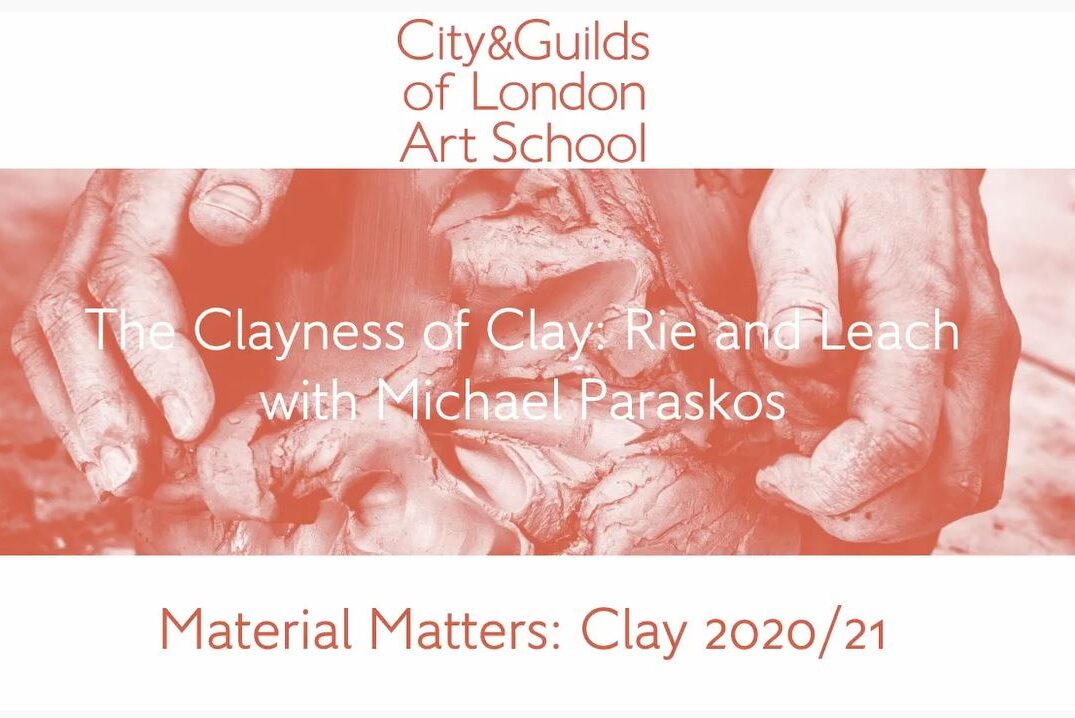Art Histories lecturer Dr Michael Paraskos discusses the material nature of postwar British ceramics, looking at objects made by Bernard Leach and Lucy Rie.
Take a look at this little milk jug. I suppose in many ways, it’s quite unremarkable, like something you might find in a country-style kitchen, certainly not in a luxury manor house or fancy penthouse apartment in Manhattan; it’s something from an ordinary kitchen. The most remarkable thing about it is the fact that it was made by the godfather of studio ceramics, Bernard Leach. And of course that’s the point: for Leach, the important thing about ceramic pieces like this was their ordinariness. There is a kind of morality in its everyday quality; it’s not meant for a prince or a city banker to show off their wealth or refined taste – it’s meant to be used by anyone.
Of course now, having a Bernard Leach pot does show a kind of refined taste, and even wealth. But in his guiding philosophy Leach wanted to revive a kind of vernacular or folk pottery tradition that he believed had once existed in England before industrialisation, in which pottery was functional, and to be used by the people who made it. Now that belief seems to be embodied in the look of this jug itself. We’re left in little doubt that it’s a handmade object, made on the potter’s wheel. It shows the marks of its making, and although it’s glazed, there was no attempt to use the glaze to hide the making process, the places where the potter’s hand once held the raw clay. In fact, Leach’s earth pigment glazes seem to emphasise, and even add to the imperfections of the piece, so that we can never imagine that this was produced by a machine.
In that, it stands in stark contrast to what we might think of as typical of say Bauhaus ceramics. Here is a tea service designed by the founder of the Bauhaus, Walter Gropius. There is very little to even suggest that these objects are made of clay, and the smooth surface and high gloss white glaze not only suggest a machine production method, but also dehumanise the pottery, taking away any sense of the hand of the maker. If Leach’s pottery revels in its own materiality, the clayness of the clay as it were, the Gropius pieces seem to want to deny their own material nature. The clay becomes incidental.
Effectively, Leach fits into a broader artistic movement that came to the fore after the first world war in both sculpture and ceramics, led by figures such as Barbara Hepworth, Henry Moore, and Jacob Epstein. For these artists, if your sculpture was made of stone, you shouldn’t try to hide the stone with over-refined carving or covering it in paint. Instead, you should celebrate its own stoniness, so that when you look at a Hepworth or Moore from this period, you’re never in any doubt as to what the sculpture is made of. And the same is true of a Bernard Leach pot. Unlike his contemporary, Walter Gropius, there is no attempt to hide the clay. And unlike some Victorian pottery, there is no attempt to make the clay look like other objects like real flowers, or animals, or fruit. The clay always looks like clay, and it always looks like handmade clay. The material nature of the pot is paramount.
So how do we fit a ceramicist like Lucie Rie into this schema? Is she more like Bernard Leach, or Walter Gropius? Looking at a bowl like this by Lucie Rie, our immediate answer might be that she is more like Gropius. Although we don’t see a high gloss white finish, the forms are regular, almost geometric in places, unlike anything we might expect to find in a Leach. The relative thinness of the clay suggests a refinement, so that it has been suggested that these are very much urban pots – perhaps even urban and urbane – and we can contrast that again with the rustic forms of Leach. Certainly, there are key differences between Leach and Rie; we can point to Leach basing himself in the rural setting of St Ives in Cornwall, while Rie was based in the heart of west London. Rie also came out of a very different arts and crafts tradition to Leach, in many ways, one that was much closer to that of Gropius. She was born into a sophisticated Viennese family, her father was a doctor, and she was trained in a middle European ceramic tradition that was far less wedded to the rough finish that we see in a Leach. Her mentors were people like the architect Josef Hoffmann.
But look again at this little bowl. The glaze is not incidental to our appreciation of it, and it moves Lucie Rie in a different direction, away from the aesthetic of Gropius. The machine production method demands standardisation and uniformity, but in Rie’s work, we often see the glazes run in unexpected directions, so that we can say with some certainty that she left this aspect of her work to chance. It’s almost as though she embraced the surrealist concept of the happy accident in which she might have had some idea as to what the glaze would be like, but the material nature of the glaze, in combination with the material nature of the clay pot, always threw up unexpected surprises.
In fact, we know that Lucie Rie embraced this element of the unexpected in her working method. While most potters fire their pots twice (first firing the clay pot without a glaze in what is called “biscuit firing”, and then firing it again in a glaze firing), Rie did not do this. She fired her pots only once, cutting out the biscuit firing. The consequence of this was that oxides and other impurities in the clay tended to bleed into the glaze, so that if you look at a Rie pot, you’ll often see a speckled or mottled effect. This is a direct consequence of this way of working, and you cannot predict what the mottling will look like. So it’s an unexpected element that is controlled, in effect, by the clay itself. So Lucy Rie may produce work that we might want to characterise as urban and urbane when set against the rustic quality of Bernard Leach, but that doesn’t make her like Walter Gropius. Like Leach, she does not attempt to completely denature her pottery. In both, there is an embrace of the materiality of clay, that clayness of clay, and a desire to allow that clay to express its own nature, and in effect dictate at least part of its own artistic form.
This can also be viewed on the Art School’s YouTube channel.
Dr Michael Paraskos studied first at the University of Leeds, and then gained his doctorate on the aesthetic theories of Herbert Read, at the University of Nottingham. He has taught at the University of Leeds, University of Hull, University of Nottingham and Cyprus College of Art, and in addition to working at City and Guilds of London Art School he also currently works at SOAS University of London and Imperial College London. Michael lectures on various aspects of art history and culture, specialising at the Art School on the architectural history of London, but he has broader interests in British art history and theory, and the historical and contemporary relationship between art and anarchism. As well as being the co-founder and co-organiser of the annual conference Othello’s Island held in Nicosia, Cyprus, he is a member of the judging panel for the annual PMSA-Marsh Award for Public Sculpture and he was elected a Fellow of the Royal Society of Arts in 2010. Michael is also the inventor of a cocktail called the Ouzini, recommended the Cyprus Weekly newspaper as “worth a try”.

